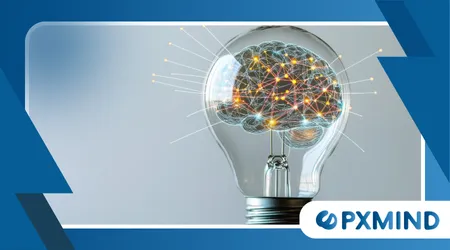Cosa dice la neuroscienza sulla creatività

L'esplorazione definitiva in Cosa dice la neuroscienza sulla creatività rivela una danza dinamica all'interno del cervello, che supera di gran lunga le semplici dicotomie emisfero destro/emisfero sinistro.
Annunci
La creatività, fondamento dell'innovazione e del progresso culturale, è oggi considerata un processo complesso che coinvolge l'intero cervello.
Questa visione sfumata, supportata da neuroimaging all'avanguardia, riformula il pensiero creativo trasformandolo da un dono mistico a una funzione cognitiva accessibile e addestrabile.
Le ultime scoperte sottolineano la sinergia critica tra reti cerebrali solitamente considerate oppositive.
Come genera il cervello idee originali? Le dinamiche di rete
Il pensiero creativo non è tanto una singola “corteccia creativa” quanto una sofisticata comunicazione di rete.
I neuroscienziati ora evidenziano la cooperazione cruciale, seppur controintuitiva, di tre importanti reti cerebrali su larga scala.
Quando generiamo un concetto veramente nuovo, due sistemi primari orchestrano un intricato balletto mentale.
Una è la Default Mode Network (DMN), spesso attiva durante i pensieri divaganti, l'immaginazione e il pensiero autoreferenziale.
La DMN è il "generatore di idee" del cervello, che collega spontaneamente ricordi e concetti disparati.
Questa natura spontanea è fondamentale per il pensiero divergente, poiché consente numerose e varie possibilità.
Il secondo è l'Executive Control Network (ECN), che regola l'attenzione focalizzata, la memoria di lavoro e l'inibizione.
L'ECN è l'“editor e selezionatore” del cervello, che valuta meticolosamente il flusso di concetti generati dalla DMN.
Fornisce la focalizzazione mirata necessaria per trasformare le idee grezze in soluzioni praticabili.
Perché la cooperazione di rete è essenziale per le scoperte?
Una creatività di altissimo livello richiede questo passaggio fluido e dinamico tra la generazione fluida della DMN e l'attenzione disciplinata dell'ECN.
Immaginiamo un compositore che improvvisa una melodia (attivazione DMN) e poi rivede meticolosamente la partitura, armonizzandola secondo la teoria musicale (attivazione ECN).
Questa interazione rapida e fluida è la firma neurologica di un'espressione creativa efficace.
Guarda quanto è interessante: Capire i neuroni specchio e la connessione sociale
In una recente analisi completa del generale Brigham del Massachusetts, pubblicata in Rete JAMA aperta All'inizio del 2025, i ricercatori hanno identificato un circuito cerebrale comune per la creatività.
Hanno valutato i dati della risonanza magnetica funzionale (fMRI) e i casi di alterazione della creatività dovuta a lesioni cerebrali. I loro risultati hanno evidenziato l'importanza del collegamento negativo del circuito al polo frontale destro.
Ciò suggerisce che la soppressione delle valutazioni autocensurate basate su regole (una funzione fondamentale del polo frontale destro) consente al flusso creativo di procedere senza inibizioni.
| Rete cerebrale | Funzione primaria nella creatività | Processo chiave |
| Rete in modalità predefinita (DMN) | Generazione di idee | Associazione spontanea, immaginazione, divagazione della mente |
| Rete di controllo esecutivo (ECN) | Valutazione dell'idea | Attenzione focalizzata, memoria di lavoro, perfezionamento, selezione |
| Rete di salienza (SN) | Meccanismo di commutazione | Rileva eventi interni/esterni importanti, gestisce la transizione DMN/ECN |
La Salience Network (SN) funge da centralino vitale del cervello.
Rileva l'importanza di un'idea emergente, garantendo una transizione fluida tra la fase generativa del DMN e la valutazione critica dell'ECN.
Questa attività coordinata a tre reti è alla base di atti creativi complessi in tutti i domini.

Possiamo allenare il nostro cervello a essere più creativo?
La comprensione delle reti neurali cambia il nostro approccio alla promozione della creatività.
Leggi qui: Il legame tra salute intestinale e funzione cerebrale
Poiché si tratta di un processo di collaborazione in rete, ciò suggerisce che la pratica deliberata può migliorare la capacità del cervello di coordinare questi sistemi.
Quali pratiche migliorano la connettività cerebrale per la creatività?
Alcune pratiche deliberate si sono rivelate promettenti nel rafforzare il collegamento DMN-ECN.
Ad esempio, è noto che la consapevolezza e la meditazione migliorano la concentrazione e, allo stesso tempo, consentono ai pensieri spontanei di emergere senza giudizio.
Questo equilibrio è esattamente lo stato cooperativo su cui si basa il cervello creativo.
Un'altra tecnica è il downtime strutturato, che consente alla DMN di prendere il sopravvento senza l'interferenza immediata dell'ECN.
Un esempio è il “periodo di incubazione”, durante il quale una persona si allontana da un problema difficile, lasciando che il suo subconscio lavori.
++ Come supportare un amico che soffre di ansia
Quando l'ECN focalizzato viene temporaneamente disattivato, il DMN può creare collegamenti nuovi e inaspettati.
Una volta ripreso il compito, l'ECN potrà quindi trarre vantaggio da queste nuove associazioni.
Per uno sviluppatore di software che si trova ad affrontare un bug di codifica complesso, il processo potrebbe richiedere un'analisi rigorosa e mirata (ECN) che però non porta a nulla.
Invece di insistere, fanno una passeggiata di venti minuti, lasciando vagare la mente (DMN). Durante questa pausa, emerge improvvisamente una nuova soluzione alternativa.
Questo è un classico esempio di cooperazione DMN-ECN facilitata dalla Salience Network.
Perché la sinergia tra spontaneità e controllo è fondamentale? Cosa dicono le neuroscienze sulla creatività
La creatività non è caos; è immaginazione controllata. Il semplice atto di generare molte idee (pensiero divergente) è solo metà della battaglia.
La vera originalità richiede di selezionare e dare forma a queste idee trasformandole in qualcosa di significativo e utile (pensiero convergente).
La funzione collaborativa rivela Cosa dice la neuroscienza sulla creatività più chiaramente: si tratta di una forma di cognizione fortemente orientata a uno scopo.
Prendiamo uno scultore. La fase iniziale prevede la modellazione spontanea dell'argilla, un'esplorazione rapida, quasi inconscia (DMN).
La fase successiva prevede la meticolosa rifinitura, misurazione, levigatura e definizione dei dettagli, un processo altamente controllato e basato su regole (ECN).
Il capolavoro finale è il risultato di entrambi, non solo dell'iniziale slancio di spontaneità. Perché spesso aspettiamo l'ispirazione invece di iniziare e basta?
La mente creativa: cosa dice la neuroscienza sulla creatività
Un'interessante scoperta statistica evidenzia la realtà del potenziale creativo: la ricerca suggerisce che gli individui creativi tendono a mostrare una maggiore connettività funzionale tra la DMN e l'ECN anche durante stati di riposo.
Ciò indica un'architettura creativa intrinsecamente "meglio connessa". Studi che utilizzano la risonanza magnetica funzionale a riposo (fMRI) hanno dimostrato questo accoppiamento più stretto.
Questa maggiore connettività a riposo tra le reti non è una caratteristica fissa; è un meccanismo neurologico che può essere migliorato.
Ciò suggerisce che gli individui con elevate capacità creative sono semplicemente più abili a passare con flessibilità dalla generazione interna all'attenzione esterna, a seconda delle necessità.
Non aspettano la musa: la loro architettura neurale è predisposta per il cambiamento flessibile.

Padroneggiare l'architettura del cervello creativo
In definitiva, Cosa dice la neuroscienza sulla creatività sfata il mito del genio solitario colpito da un fulmine.
Presenta invece una visione ottimistica e scientificamente fondata: la creatività è il prodotto di reti neurali ben coordinate.
Si tratta di un'abilità che si può allenare e che affonda le sue radici nell'elegante collaborazione tra la nostra capacità di pensiero spontaneo (DMN) e la nostra capacità di controllare e perfezionare tale pensiero (ECN).
Impegnandoci in attività che incoraggiano questa interazione dinamica, che si tratti di pratica consapevole, pause strutturate o passaggi deliberati tra brainstorming e critica, possiamo coltivare intenzionalmente un cervello più creativo.
Il futuro dell'innovazione appartiene a coloro che padroneggiano la sottile e potente sinergia della propria architettura neurale.
Domande frequenti
La creatività risiede solo nell'emisfero destro del cervello?
No, la neuroscienza moderna confuta definitivamente il mito del “cervello destro/cervello sinistro” per la creatività.
Gli studi sulla risonanza magnetica funzionale dimostrano che la creatività implica l'interazione dinamica di reti cerebrali su larga scala in entrambi gli emisferi, principalmente la rete della modalità predefinita e la rete di controllo esecutivo.
La neuroplasticità può aumentare la mia capacità creativa?
Sì. La neuroplasticità si riferisce alla capacità del cervello di riorganizzarsi formando nuove connessioni neurali.
Poiché la creatività si basa sulla connettività funzionale tra reti (DMN ed ECN), impegnarsi in attività che promuovono questa interazione, come l'improvvisazione o la risoluzione strutturata dei problemi, può migliorare la capacità creativa nel tempo.
Quale rete cerebrale è responsabile della generazione di nuove idee?
La rete in modalità predefinita (DMN) è la principale responsabile della generazione spontanea di nuove idee.
È attivo quando la mente vaga, collegando ricordi e concetti apparentemente non correlati, il che è fondamentale per la fase iniziale e divergente del pensiero creativo.
In che modo Salience Network contribuisce alla creatività?
La Salience Network (SN) agisce come un interruttore cognitivo. Monitora gli stimoli interni ed esterni e aiuta a determinare quando spostare l'attenzione.
Nella creatività, è essenziale decidere quando passare dalla fase di generazione libera associativa (DMN) alla fase di valutazione critica e perfezionamento (ECN).
